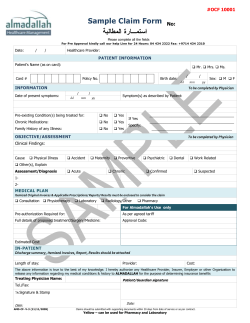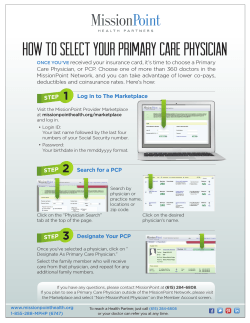
Suffering from Back Pain?
did you know? Now there’s a new option for patients suffering from low back and leg (radicular) pain due to contained disc herniations, especially for those who have failed conservative treatments and are interested in trying minimally invasive options prior to considering traditional back surgery. Description The DEKOMPRESSOR® is a single use disposable discectomy probe that passes through and works in conjunction with an introducer cannula to remove intervertebral disc nucleus pulposus material. Joint Replacement Trauma Spine The procedure is called Percutaneous Discectomy. It is performed under x-ray using local anesthetic (sometimes with light sedation). It is much less invasive than traditional surgical treatments. frequently asked questions What type of pain can be treated? Low back and leg pain due to contained disc herniations. How does the procedure work? The DEKOMPRESSOR® discectomy probe removes disc tissue which may relieve painful pressure on the surrounding nerves. Will the procedure hurt? There should be no pain generated by the DEKOMPRESSOR® discectomy probe. This advancement in technology requires only a tiny puncture in the skin; similar to a simple injection. How long does the procedure take? Intended Use The Dekompressor® Percutaneous Discectomy Probe is intended for use in aspiration of disc material during Percutaneous discectomies in the lumbar, thoracic and cervical regions of the spine. Contraindications 1. Traumatic spinal fracture, infection, tumor, pregnancy, and severe co-existing medical disease are contraindications. 2. The probe is not appropriate for treating patients who present with pain originating from structures other than herniated discs. Patients presenting with free fragments, severe bony stenosis, or severely degenerative discs should be excluded. 3. The procedure should be performed under local anesthesia or conscious sedation to allow patient monitoring for signs of segmental spinal nerve irritation. General anesthesia is contraindicated. 4. Patients with severe and rapidly progressing neurological deficits should be excluded. Interventional Pain Micro Implants Suffering from Back Pain? Orthobiologics Instruments DEKOMPRESSOR® Interventional Pain Percutaneous Discectomy Probe Navigation Endoscopy Communications Patient Handling Equipment EMS Equipment Potential Complications Potential complications include: infections, bleeding, nerve damage, worse pain, failure of technique, paralysis, idiosyncratic reaction, anaphylaxsis, & death. The total procedure time is generally 15 minutes to 1 hour. What physician training is required to perform this procedure? Board certification in a specialty such as interventional pain management, orthopedic surgery, neurosurgery, radiology, or physiatry is typical. Physicians should be experienced with discography. To schedule a consultation, please contact: an important advancement for patients suffering from low back or leg pain due to contained disc herniations Can my pain be cured? In some cases, pain may be eliminated. In most cases, percutaneous discectomy followed by appropriate follow up care will reduce pain to a tolerable level. For more information, visit www.dekompressor.com or contact your local Stryker Sales Representative. 1000-204-920 Rev. B Stryker Instruments 4100 East Milham Avenue Kalamazoo, MI 49001 USA t: 269 323 7700 f: 800 999 3811 toll free: 800 253 3210 frequently asked questions Before Your Procedure: What to expect prior to your procedure: Will the procedure hurt? The physician will use local anesthetic to numb the area to be treated, and the patient should experience minimal discomfort throughout the procedure. Additional numbing medicine may be given as determined by the physician. How long does the procedure take? The total procedure time will only take on average 30 minutes. Can my pain be cured? Your back or neck may remain painful for about 1-4 days after the procedure. This is usually caused by muscle spasms and residual effect of the nerve being ablated. After this period you will begin to feel the pain relief, which can last anywhere from 9 months to 2 years. The nerves will eventually regenerate and additional procedures may be required. • Bring in any recent films, X-rays, MRI’s, and reports to your physician • Notify your physician of all current medication and medical conditions • Notify your physician of any allergies to specific medications • Do not take any blood thinning medication 2 days prior to procedure • Do not take anti-inflammatory medication 5 days prior to the procedure • Do not take food or drink 6 hours prior to your procedure except sips of water for medication • Arrange for transportation home from a family member or friend What to expect on the day of your procedure: • The physician will review all current medications, MRI’s, and films • Plan to arrive about 1 hour before the procedure • An IV may be started, once placed the IV will be able to administer conscious sedation and other medications if needed • You will lie on your stomach while the doctor applies local anesthetic to your back • The procedure will be performed under fluoroscopy or live video x-ray to confirm proper needle placement • You will be awake during the entire procedure to provide feedback to the physician in order to ensure the symptomatic area is treated • Once the needle and electrode are placed correctly, a small radiofrequency current is sent through the electrode into the surrounding tissue causing it to heat. • This step may be repeated for other sites if the physician deems it necessary About the cost: Radiofrequency nerve ablation is covered by most insurance plans. Co-pays and deductibles will vary based each plan. Coverage can be discussed with the facility where the procedure will take place. Typical Post Procedure Recommendations: • The patient will be brought to a recovery room for approximately 60 minutes, he/she will be discharged if the recovery is uneventful • Some initial numbness may be experienced, afterwards you will experience pain relief • Plan on limited activity for 24-48 hours after the procedure • Your physician may have recommendations for post-procedure protocol • Any increased pain during the first few days, due to tissue wounds or nerve irritation, should subside shortly after the procedure • The patient may eat or drink soon after the procedure • Have a family member or friend drive you home • Pain medication may be given to treat any soreness or spasms • Normal everyday activities may be resumed depending on the patient and when he/she feels better • The nerves will eventually regenerate, and the pain relief may last anywhere from 9 to 14 months or longer based on the patient. Additional treatment may be required • Potential complications may include nerve irritation, back pain where the needle is inserted, and leg or back weakness *This information is not meant to be substituted for the advice provided by a physician or other medical professional. You should consult with a physician or medical professional to determine what instructions may be appropriate for you.
© Copyright 2025











